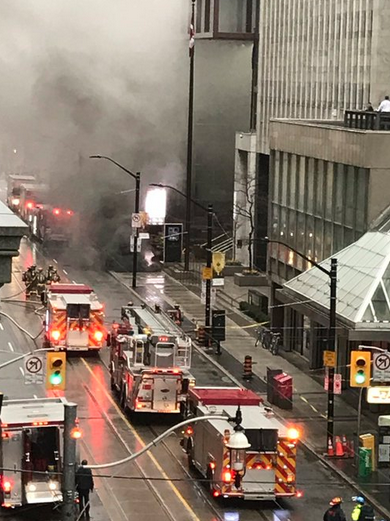If I were asked by someone in Toronto in the weeks ahead of yesterday’s international May Day demonstrations “what should I be most concerned about on May Day,” I would have rattled off some concerns about protests, vandalism, the potential for escalation, lone actors and small groups attempting acts of violence and vandalism and concerns regarding the potential of terrorism. You know, the type of stuff we expect from the US Pacific Northwest and California… I would not have listed underground sidewalk explosions high on my list. Shame on me.
From the National Post: “A series of explosions beneath a sidewalk grate in Toronto’s financial district on Monday sent thick smoke into the street, forcing evacuations and effectively shutting down one of the city’s — and Canada’s — busiest inters ections in the middle of afternoon rush hour. It appears the blasts came from a fire in a hydro vault, which one Toronto Fire spokesman described as an underground concrete room with a transformer inside that powers the Royal Bank of Canada tower near King Street and Yonge Street. Police said no injuries had been reported… Capt. Adrian Ratushniak, a Toronto Fire spokesman, said firefighters on scene reported hearing continuous blasts from inside the hydro vault. The vault is underneath the sidewalk outside the Royal Bank Building, which was reporting power loss after the explosion, said Florence Gabriel of Toronto Hydro. ‘So that vault likely supplies power to that particular building,’ she said. Heavy smoke billowed through King Street and snaked down into the PATH system, an underground network of walkways for downtown commuters… The incident shut down a nearby subway station and caused several streetcars to take detours. Police cruisers blocked off streets in the area and officers were seen wearing surgical masks. People were evacuated from both the PATH system and the Royal Bank building at 20 King West, Ratushniak said.”
ections in the middle of afternoon rush hour. It appears the blasts came from a fire in a hydro vault, which one Toronto Fire spokesman described as an underground concrete room with a transformer inside that powers the Royal Bank of Canada tower near King Street and Yonge Street. Police said no injuries had been reported… Capt. Adrian Ratushniak, a Toronto Fire spokesman, said firefighters on scene reported hearing continuous blasts from inside the hydro vault. The vault is underneath the sidewalk outside the Royal Bank Building, which was reporting power loss after the explosion, said Florence Gabriel of Toronto Hydro. ‘So that vault likely supplies power to that particular building,’ she said. Heavy smoke billowed through King Street and snaked down into the PATH system, an underground network of walkways for downtown commuters… The incident shut down a nearby subway station and caused several streetcars to take detours. Police cruisers blocked off streets in the area and officers were seen wearing surgical masks. People were evacuated from both the PATH system and the Royal Bank building at 20 King West, Ratushniak said.”
In life, it seems the problem we plan for is rarely the problem we face. This often holds up in security and preparedness as well. Had this incident been larger, and caused major outages across the local area of Toronto, would a facility security or risk manager who had prepared for the May Day threats I was more concerned with have been ready for a potential power outage and other disruptions to their facilities’ critical infrastructure lifelines? I don’t know that she would have been but she certainly should have been!
 While the actual “adversary” may change and issues may manifest differently than we planned for, differently than “last time,” or differently from what we last exercised, the preparedness actions taken ahead of what we planned often translate to reduce the impacts of the unplanned for adversary.
While the actual “adversary” may change and issues may manifest differently than we planned for, differently than “last time,” or differently from what we last exercised, the preparedness actions taken ahead of what we planned often translate to reduce the impacts of the unplanned for adversary.
Effective preparation for potential physical security disruptions on May Day due to “protests gone wild,” would have contributed greatly to being ready to respond to a significant power outage and critical lifeline disruptions. A good leader would have already talked to his neighbors about their security issues and response procedures and any dependencies his facility had on theirs. A good leader would have reviewed evacuation plans and communications to ensure she could safely move personnel to a safer location. A good leader would have prepared for the potential of having to conduct continuity of operations ahead of, during, or after major security concerns. Remote work plans or alternate facilities would have been checked – ideally exercised – and reminders for the potential of having to use them would have been communicated to staff. A good leader may not have been through a significant physical security disruption before, or yet been able to prepare for natural disasters or malicious attacks that caused power and other lifeline disruptions, but she would have put some plans into place, conducted some of the training she wanted, and at least going through some level of exercise activity before the incident. Having done some – because we never get to do all – of what could have done from a preparedness standpoint, would have allowed a reasonable pivot to effectively respond to a different incident than what may have been anticipated.
So – maybe it won’t be SARS, or a DDoS attack, or an Active Shooter, or Spring Flooding that “attack” you. But it will probably be something similar to what you should have planned for. That allows a good leader and their staff to be able to adjust, make some decisions, and carry on to support effective operations and the safety of staff, patrons and others. You might not have planned for exploding sidewalks, but if you properly prepared for “something,” exploding sidewalks probably would be manageable too.
This blog was written by Andy Jabbour, Gate 15’s Co-Founder and Managing Director. Andy leads Gate 15’s risk management and critical infrastructure operations with focus on Information Sharing, Threat Analysis, Operational Support & Preparedness Activities (Planning, Training & Exercise). Andy has years of experience working with partners across the critical infrastructure and homeland security enterprise to support national security and client business needs.
Header Photo via CBC News: http://www.cbc.ca/news/canada/toronto/toronto-explosion-1.4094416
National Post article, written by Jake Edmiston, 01 May: http://news.nationalpost.com/toronto/police-investigate-loud-blasts-smoke-pouring-onto-street-in-downtown-toronto
Top image via Himel Khandker, @DonkeyKhan via Twitter
Bottom image via Naheed Dasani, @NaheedD via Twitter
